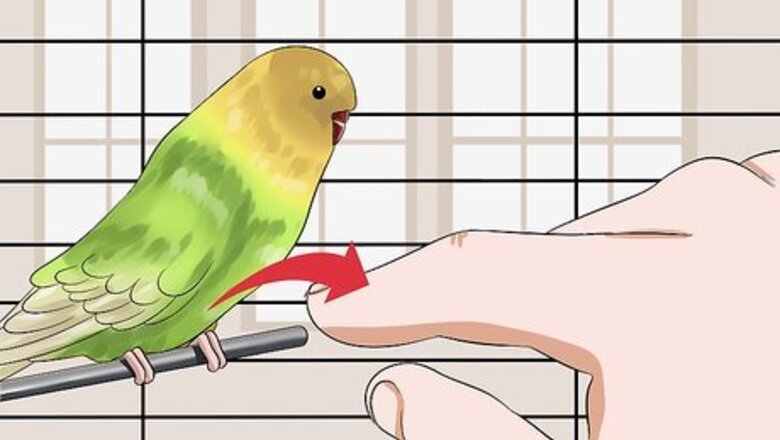
views
Teaching Tricks
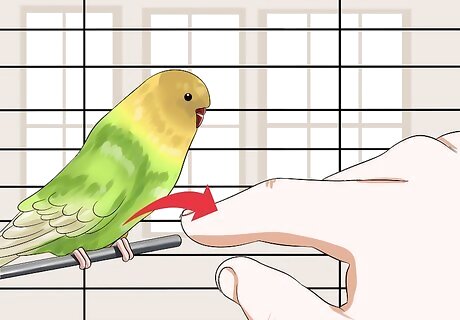
Encourage physical contact. Once your budgie is settled, place your hand in the cage and keep it immobile. Repeat this for days to let your bird get used to your physical presence in the cage. When the budgie seems okay with your hand, place your finger inside the cage. Then push it slightly against your budgie’s chest. This will encourage it to climb on your finger. Be patient as the bird might be reluctant at first. If the bird is intimidated, just stroke its breast with the back of your finger. Show love and care. Alternatively, you can put a few seeds on your finger. Your budgie will probably climb on your hand to eat them. Doing this for a few days will teach your pet to trust you. You can hold other high-quality treats like millet to get your budgie more comfortable around your hands.
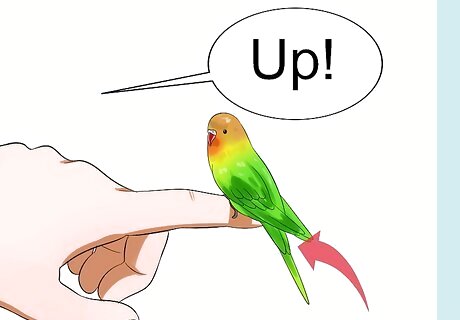
Start using directions. When talking to your budgie, start using instructions like "Step Up!" and "Step Down!" to coincide with its hopping on and off your finger. Repetition is the key to getting him to perform an action according to your words (which are just sounds to him). Offer a treat when your budgie does something following your instruction. This will reinforce the desired behavior. Be persistent and consistent. You will need to focus on one instruction at a time, and for quite a while until your budgie repeats on cue. Persevere and don't vary the routine; this increases the chances that your budgie will learn faster.
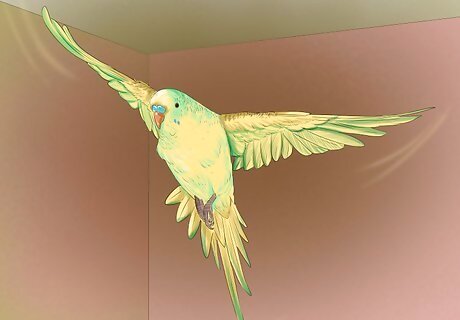
Teach your budgie to fly to you. Have your finger super-close, but not too close that your bird can just step up. It needs to hop. Bring your finger half an inch further and reward your budgie with a millet each time your budgie flies to you. Practice this and bring your finger further and further each day. To teach your budgie to step off of the perch you are holding and onto its cage perch, use the same command and steps given in the “step off finger” trick. To teach your budgie to fly to its perch, point to the perch and say "go back to your perch." Reward the budgie when it goes to the perch.

Teach your budgie “Towel Training.” This teaches your bird to be comfortable with being wrapped in a towel when it is sick or at the vet. To teach your budgie how to be wrapped in a towel, you must first let the budgie explore the towel. Lay it flat out on the table with its favorite treat or toy and let it walk onto the towel. Repeat this many times. Next, you can practice holding the towel while the bird is on it. Hold it in a slightly “cupped” way, and let it continue to eat the treat or play with its toy. Repeat this step every few hours for a few minutes at a time. Then, curve the towel around the bird and hold it more firmly. Keep repeating this process until your budgie is all wrapped up. Every time you do this, gently stroke or extend the bird’s wings and feet. It will get used to its wings and feet being touched at the vet. Repeat the “wrap up” every day with a positive attitude and lots of treats. Your budgie will become comfortable with being wrapped in a towel for nail trimmings, wing trimmings, and such.

Train your budgie to balance on a tennis ball. Once your bird knows basic directions, it’s time to make things more difficult. Introduce a tennis ball in its cage and let the bird play for a few days. Follow the following steps: Try to put the budgie on top of the tennis ball and hold its body while the feet look for balance. Every time the budgie tries to balance itself with its feet, offer a treat. Don’t force your bird to learn a trick for too long. 10-15 minutes per day is enough. Remember that your bird should have fun! Leave the ball in the cage. Your budgie will eventually understand the purpose of the exercise and balance on its own on the ball. Be gentle when you hold the budgie on the tennis ball. Remember that they are fragile birds.
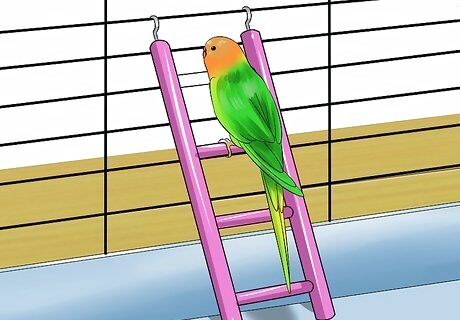
Teach the budgie to climb a ladder. You can find plastic bird ladders in most pet shops. Fix it to the side of the cage. Your budgie will be naturally intrigued by the ladder and will want to climb it. Every time the bird tries to climb the ladder, say the same word, like 'climb', to let your bird make the association between its action and your order. The trick is to make your budgie climb when you order it. Be patient and gentle. Place your bird on the lowest end of the ladder and hold it. Say the word associated with climbing and release your budgie. Once your bird understand what is expected, don’t place it on the lowest end of the ladder but a few centimeters from it. Increase the distance every day until your budgie obeys without physical contact.
Learning To Speak And Sing
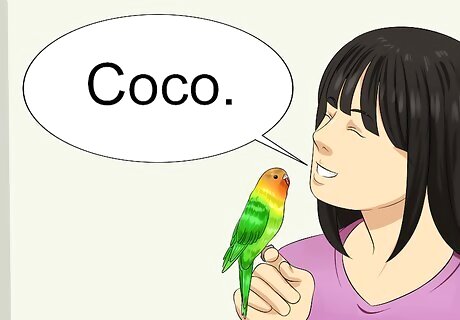
Teach your budgie its name. It is easier to start with the animal’s name as it hears it all the time. Repeat your budgie’s name every time you see it and when you bring food. Try to speak in a high-pitched voice and say the name slowly and clearly. Wait until the budgie is old enough. The bird should be at least three months old before it can speak. If you have more than one budgie, stick to the teaching of one name. You don’t want to make it too hard at first. Don’t forget to reward your budgie. If it doesn’t learn quickly, don’t punish it. It doesn’t understand right or wrong and will just mistrust you.

Expand its vocabulary. Talented budgies can learn over a thousand words over their lifetime. Once your bird knows its name, target the words you want to teach. Your budgie will eventually make the connection between the words and the objects or actions. Repetition is an essential part of teaching your budgie learn new words. When you enter the room, systematically say ‘hi coco [or the budgie’s name]’. When you feed it, point at the seeds and say ‘food’. Look at their corporal language and take advantage. When the bird is in a threatening posture (biting or pecking), say ‘Angry’. When the budgie is resting on one leg and looking happy, say ‘happy’. Your budgie can also say simple sentences. When your bird eats, say ‘coco [or the bird’s name] eats’. When it drinks, say ‘coco drinks’. Don't teach your bird insults. The budgie will remember it for a long time and might embarrass you in front of your guests.
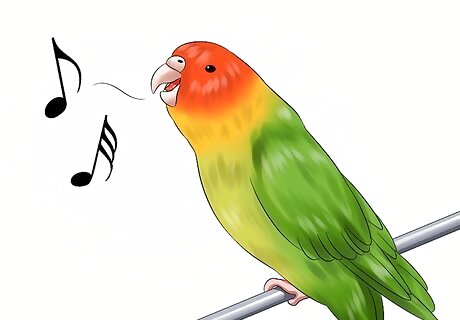
Teach your budgie a song. There is nothing funnier than having your bird singing a song. Your budgie can remember simple tunes and will happily delight the whole family. The easiest way to teach a song is to sing it over and over to your bird. Don’t try to teach the whole song but just a few seconds. Pick a song you like. Remember that your budgie might sing it for a long time. Record yourself singing a song and play it to your bird when you’re away. This is an extremely efficient way to teach a song without having to sing it a thousand times. You can do the same to teach words. The actual recording of a song might not be the best way to teach the bird. The instruments will probably disturb it.
Earning Your Budgie's Trust
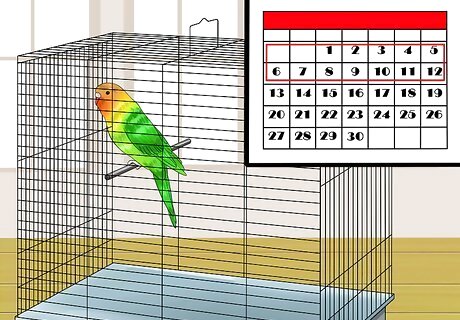
Make your budgie feel at home. If your budgie is new, it will need time to get used to its cage. You should let it adjust for at least a few days and make sure that the bird is in a quiet environment before attempting to train it. By this time, the budgie should start to relax and feel comfortable. Make sure to read the wikiHow tutorial on how to take care of a budgie. Stay close to the cage. Talk to it quietly as you wait for it to adjust but do not try to handle it. It will get used to you in the course of a few days or weeks. Avoid loud noises and screams. Your budgie is likely to be stressed by this new environment. Name your budgie. Say it often, especially when you feed it, so that it gets used to its new name. Read your bird a story. This might sound strange but budgies like to hear their owner's voice. Reading them a book will sooth them and make your voice familiar.
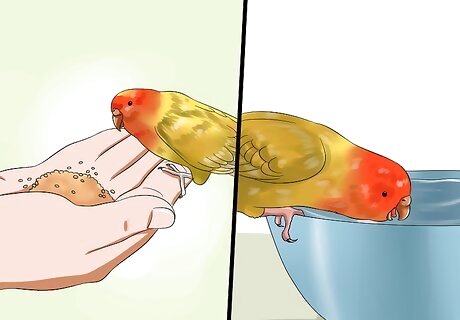
Feed and water the budgie daily. The budgie will slowly recognize you as the one providing food. The bird will trust you faster and will be excited when seeing you. Water and food should be changed daily, even if the budgie hasn't touched it. A new budgie will often refuse to eat for up to a week, as it gets used to its new life. Introduce your budgie to treats before training starts. Give it a piece of fruit or a few seeds. Your bird will love it and will be more willing to learn if it has an incentive. Don't exaggerate with treats as you want to keep your bird healthy.
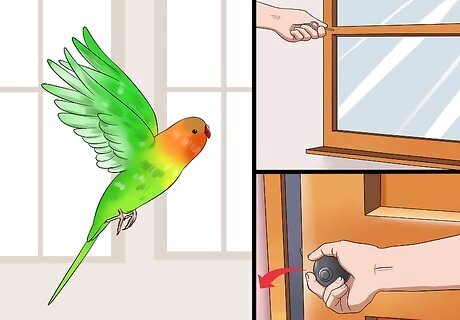
Let the budgie fly in a room. Once the bird is at ease with you, you can let it fly in a room with all of the windows and doors closed. This extra space will make your budgie happy and will keep it fit for the forthcoming training. To call it back, switch off all the lights and leave the curtain of one window open, but remember to close the window. The budgie will be attracted towards the light. Hold it gently and put it back inside the cage. Make sure that there is no cat or predator in the room. If you have a child, don’t let him/her frighten the bird. Budgies are easily traumatized.


















Comments
0 comment